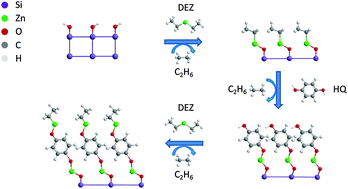Organic–inorganic hybrid semiconductor thin films deposited using molecular-atomic layer deposition (MALD)†
Abstract
Molecular-atomic layer deposition (MALD) is employed to fabricate hydroquinone (HQ)/diethyl zinc (DEZ) organic–inorganic hybrid semiconductor thin films with accurate thickness control, sharp interfaces, and low deposition temperature. Self-limiting growth is observed for both HQ and DEZ precursors. The growth rate remains constant at approximately 2.8 Å per cycle at 150 °C. The hybrid materials exhibit n-type semiconducting behavior with a field effect mobility of approximately 5.7 cm2 V−1 s−1 and an on/off ratio of over 103 following post annealing at 200 °C in nitrogen. The resulting films are characterized using ellipsometry, Fourier transform infrared spectroscopy (FTIR), transmission electron microscopy (TEM), UV-Vis spectroscopy, transistor behavior, and Hall-effect measurements. Density functional theory (DFT) and many-body perturbation theory within the GW approximation are also performed to assist the explanation and understanding of the experimental results. This research offers n-channel materials as valuable candidates for efficient organic CMOS devices.



 Please wait while we load your content...
Please wait while we load your content...